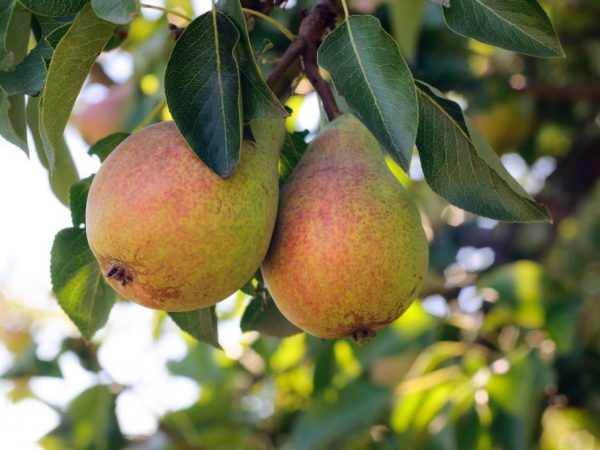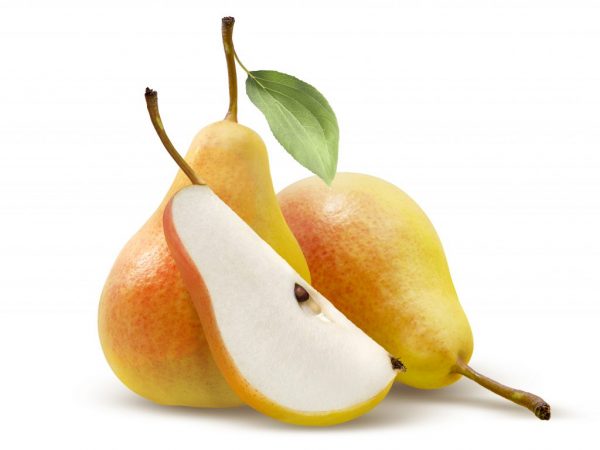Description of pear Lada
Pear Lada is a high-quality early ripe hybrid, which was bred by domestic Moscow breeders. The variety is believed to open the pear harvest season. A detailed description is presented in the article.

Description of pear Lada
Characteristics of the variety
The variety is self-fertile. This means that even a lonely growing tree can please with a decent harvest. To achieve the best result, it is recommended to place the hybrid next to such varieties as Severyanka, Chizhovskaya, Otradnenskaya. They are excellent pollinators for Lada.
The pear variety Lada belongs to the unpretentious species. The seedlings successfully survive the cold winter months even without shelter. The resistance of the hybrid to various diseases and pests is also encouraging.
Description of the plant
The tree is of medium height and size, rarely grows above 2.5 m. It has a neat crown of medium density, which, as it grows, changes its shape from funnel-shaped to pyramidal. Trees do not need constant pruning.
The bark is dark gray, on young shoots it is much lighter and with a brown tint. Young branches are of medium thickness and rather long, without edges. The cone-shaped buds are brown in color.
Leaves are of medium size and thickness. They have an elongated shape. The color is deep green. On the outside they have a beautiful glossy surface, on the back - matte and slightly rough.
The description of the variety indicates abundant flowering. The inflorescences are of the brush-like type, with 5-7 flowers in each. The buds are medium in size and white in color.
Description of fruits
Lada pears are small, egg-shaped. Their weight does not exceed 110-120 grams. The fruits are colored yellow with a light red tint and poorly expressed subcutaneous punctures. The surface is smooth, glossy.
The pulp is grainy and not very juicy, has a slightly yellowish tint. The taste is sweet and sour, the aroma is poorly perceptible.

Fruit weight does not exceed 110-120 grams.
Benefits
The advantages include the following characteristics of the variety:
- early ripening of fruits;
- good productivity;
- the ability to give stable yields without the participation of pollinators (self-fertility);
- resistance to many diseases;
- the ability of the fruit to remain on the tree for some time;
- the variety is not picky about care and growing conditions;
- good tolerance to cold weather and a sharp change in temperature.
Landing rules
It is very important to choose the right time for planting. It is believed that seedlings take root best in autumn (late September) or in spring.
It is necessary to choose a place where the sun's rays fall well. But the plant does not tolerate heat well. This suggests that with an overabundance of light, it is better to shade it. The hybrid is not picky about the soil, but the use of black soil or drainage will clearly not be superfluous.
The dimensions of the pit for planting must exceed the dimensions of the root system of the plant. A deepening of a meter diameter of 60-70 cm in depth is considered standard.The planting site is well dug, fertilizers are introduced into the pit, consisting of potassium salt, compost and superphosphate.
The plant is carefully lowered into the planting hole, making sure that 5 cm of the root collar remains on the surface. After planting, it is necessary to compact the soil well and water the plant abundantly. In order for the crown to form successfully, it is recommended to use a peg driven into the soil near the plant, the height of which is 60-70 cm.

It is best to plant in the fall (late September) or in the spring.
Care
Care is quite simple, it will help the seedling to take root well, get a healthy adult plant, speed up the ripening of fruits and protect the plant from possible diseases.
Watering and feeding
Watering pears of the Lada variety should be not very frequent, but abundant. Enough once a week, while each plant should receive 2-3 buckets of water. It is worth watering pears more often only at the time of fruit setting, since transfusions contribute to the development of diseases and can lead to the death of the tree.
Irrigation is often combined with fertilization. Mineral dressing is dissolved in water and applied to the soil. In addition, plants need regular organic feeding, especially during fruiting. Nitrogen fertilizers are used in early spring before bud break.
Pruning a mature tree
Pruning of an adult tree is carried out twice a year (summer and winter processing), if necessary. Extra shoots are removed in the spring, and dried and weak in the fall. After that, garden putty is applied to the cuts.
Possible diseases
Lada pear is famous for its immunity to many diseases. For her, diseases such as scab and fruit rot, as well as powdery mildew and bacterial burns, are practically not scary.
It is possible to talk about the complete safety of a plant only when using preventive measures. The processing of an adult plant is carried out in the spring before the start of the movement of juices. In addition, each plant is treated with a urea solution three times.
In order to protect trees from aphids, gall mites and others, they use special means to combat parasites, and also whitewash the trunks.
Conclusion
An excellent argument that the pear of the Lada variety has been at the peak of popularity among gardeners for more than one year is the huge number of its advantages. The variety is not picky about care, so even beginners can grow it.


